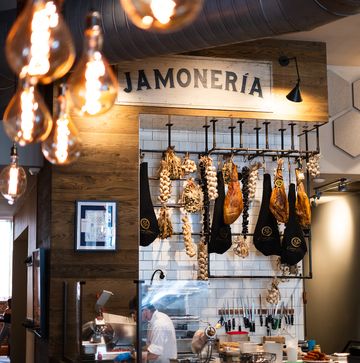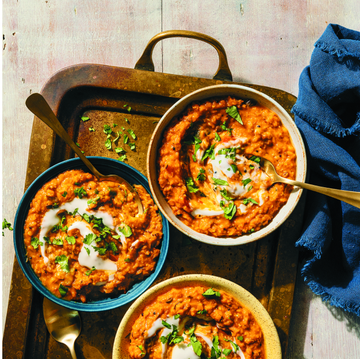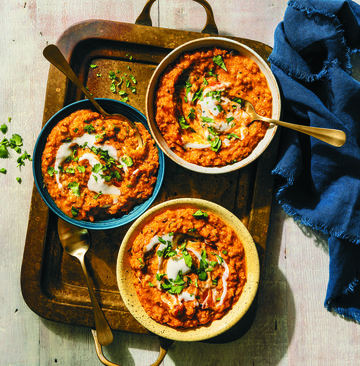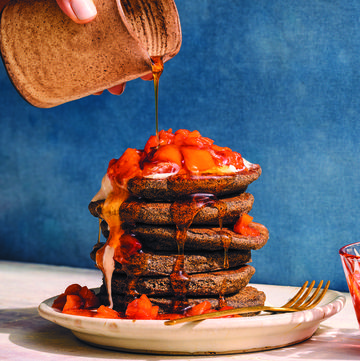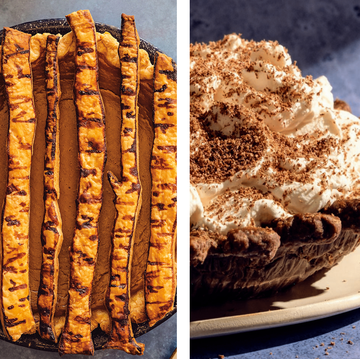In The Cooking Gene, his award-winning first book, Michael Twitty, the celebrated culinary historian, embraced the discomfort of the South’s racialized past to broaden our understanding of African American culinary identities. Now he’s turning his attention to Jewish cooking. His new book, Koshersoul: The Faith and Food Journey of an African American Jew, welcomes us into a conversation between two parts of his identity—Black and Jewish—to explore the marriage of these distinct cultures through the marriage of their distinct food traditions. Part biography and part memoir, Koshersoul is at its heart an acknowledgement of the lives and culinary contributions of Jews of color, whose identity and legitimacy is questioned as much as it is ignored.
Like The Cooking Gene, Koshersoul is also intensely personal. Twitty uses food as his primary lens to navigate both his “citizenship within Jewish community and his birthright as a Black man in America.” Yet, he also graciously makes room at the table for others, many more, in fact, as he journeys into what it means to be a person with multiple families. To do this, Twitty has generously seasoned Koshersoul with mayseh, a Yiddish word meaning “anecdote” or “tale.” Mayseh come in many forms throughout the book—conversations, letters, prayers, intimate personal stories, recipes—but all are crucial to the essence of both Koshersoul and koshersoul cooking, which are as much about resisting culture erasure as they are about redefining our narrow concept of family.
I first met Michael Twitty several years ago in Harlem after listening to him speak with the gifted chef and culinary historian Therese Nelson at the Schomburg Center for Research in Black Culture. Listening to their conversation that hot summer afternoon about the culinary consequences of slavery inspired me, even setting me on my own book path exploring how the violence I have witnessed working in war zones changes food cultures. I spoke with Michael in July about his new book, about popular misconceptions of Jews of color, and how you don’t have to be Black or Jewish to love koshersoul food.
Michael Shaikh: Hi, Michael.
Michael Twitty: Hi. How are you?
Shaikh: Good. And I'm thankful for the work that you've done. So maybe you can start by telling us, what's the connection between The Cooking Gene and Koshersoul?
Twitty: The Cooking Gene and Koshersoul are parts of a tripartite trio of books that talk about identity. It's interesting how Koshersoul is already about being at sort of the crossroads to so many different things. So my third project would be about gay identity in food and cooking.
Shaikh: What does the phrase koshersoul mean? Who is it for, and what do you want your readers to walk away with?
Twitty: It's the food of Black women who cooked for Ashkenazi Jewish households in the Deep South. It's the food of African American Jewish communities historically. It's the food of people who come in, who are brand-new, who are now blending these very global approaches to African diaspora, African Atlantic and Jewish diaspora, Jewish food. It's fusion. It's not fusion, it's inclusion. It's exclusion; it's all of those things. And it's the history of the people who make that food and what they bring to this nexus of Black Jewish engagement in North America in particular.
Shaikh: Are you saying that it is hard to identify this group clearly? Or that people have a limited idea of Jewish identity?
Twitty: Since World War II, people [especially in the U.S.] have had a really hard time understanding and seeing Jews as anything but [White in the American sense] people who were exiled and expelled during the reign of terror against Jews in Europe. However, the antiquity of the Jewish people has us born where Southwest Asia meets Northeastern Africa. Moshe Rabbenu, the figure most people refer to as Moses, the biggest prophet in Judaism and teacher in Judaism of the law, was born in Africa. When we come out of Africa during the Exodus, we're known as an ʿerev rav, which means a mixed multitude. E pluribus unum. It's very chiaroscuro. We may come in lots of colors, but we carry all of these roots and narratives.
Shaikh: Can you say more about people’s expectations for what being Jewish “looks” like? Or what “Black” belief and religion is supposed to look like?
Twitty: If you're of African descent, you encounter assumptions. Somehow being Black and Muslim and Black and Christian is absolutely normal, but being Black and Jewish is... weird or problematic, or people say, “That’s a choice.” People see me and say, “That can't be right.”
If you took a lot of people from the European Jewish diaspora back in time [to visit] their ancestors living in Iraq and Iran, in ancient Israel, Palestine, and other places, they wouldn't know what to do with them. There's a moment in the Torah when Jacob blesses his grandchildren through Joseph. They have been raised Egyptian. They're running around with cornrows. Jacob sees this and puts his hand on their head to bless them and he’s like, “Who are you?”
Shaikh: Can you speak about the population of Black Jews in America? How big is the community?
Twitty: We have between 50,000 and 100,000 people who... Are they Black? Are they Jewish? Are they halakhically Jewish? [Jewish by virtue of practicing the laws and tenets? Or because their mother was Jewish?]
When it comes to Blackness, it has been way too easy to just be like, "Well, I guess I'm just Black." Because one drop rule: Black. It's, are you on the white team or the Black team? To answer your question, it's hard to tell you distinct numbers because we've only really begun to have synthesis among the Jewish community to actually talk about who is defined as African American or not.
Shaikh: Can you talk about the letter in Koshersoul to your former students about being Jewish and LGBTQ+? And, perhaps, how that might help others help navigate their complex identity in these times?
Twitty: The letter to my students is all about from me, saying to them that I've been there, other people will be where they're going, and have been. And that it's a cycle, and uniquely in Judaism and Jewish peoplehood, it's important that they find their place. We use the euphemism makom in Hebrew. It means “place,” but also means “the presence of God.” I wanted my students and others to really find their places. I've found my place, and it's not a linear journey. None of it is. It's very difficult. Every day, in different circles, people express identities that are specific to them in colorful ways using the tools of the world around them. And they're trying to communicate something about themselves and the human condition.
Shaikh: But your identity also exists within a Venn diagram of family. This is one of the major themes of Koshersoul, family. What is the significance of family for you?
Twitty: A big part of what family does is see us. Family reifies us. Family validates us. I think it's important that we understand that our mishpacha, our kinfolk— part of their job is to give us the ability to be our full selves in this life.
Shaikh: About the recipes in the book, it may seem odd to see macaroni salad and Southern fried chicken and collards alongside latkes and kugel. Can you tell me how these seemingly different culinary traditions can be part of the same family of traditions?
Twitty: I also wanted to show people that if you were Jewish in the Deep South, none of that would be uncommon. I have menus reflecting all parts of the African Atlantic, but also reflecting different regions within Jewish culture and different styles and influences of cooking. All of that's in there.
Shaikh: Some of these recipes are no longer made. What does that feel like to make something out of history, to really be able to taste something that has this long historical tail?
Twitty: It's being electric and wooden at the same time. It is both the best of resurrection and the awareness that, Okay; this is wood. It's both alive and dead.
We bring them back to life as we can. And there is, for me, a certain pleasure in creating and bringing recipes back as they're written down and saying, "Okay. That's really cool. I'm learning something from this." And talking to the recipe author, if there was one, and saying, "I'm learning from you."
It's all just the thrill of making sure that the tradition does not die with you. And it's also having another rung of experience and skill behind you that you can therefore build on to make something new. So to be old, to be now, to be new.
Yam Kugel
Although frequently translated as “pudding,” the traditional Ashkenazi dish kugel takes a thousand forms and has diversified even further in an American cuisine, where casseroles and hot dishes abound. Inspired by the traditions preserved by Mrs. Mildred Covert, this side dish relies on plump, sugary sweet potatoes to bridge Southern sweet potato casserole with the Eastern European standby kugel.
Serves 6–8
2 cups shredded raw sweet potatoes
¾ cup margarine or vegan butter,
melted
¾ cup packed brown sugar
1 cup flour
1 teaspoon baking soda
½ teaspoon cinnamon
½ teaspoon ground nutmeg
½teaspoon salt
½ cup raisins or plumped dried
mango, cut into small pieces
½ cup chopped pecans (optional)
Combine the sweet potatoes, margarine, and sugar; mix well. Combine all
the dry ingredients; then add to the sweet potato mixture, mixing until just
moistened. Fold in the raisins or mango. Pour into a 9-inch square or round
baking dish. Top with pecans if desired. Cover with foil and bake at 350°F
for 1 hour. Uncover, continue baking for 10 minutes.
Michael Shaikh is writer and human rights investigator based in New York City. His book explores how contemporary violence alters our food cultures (forthcoming from Crown, 2023).
Explore books by Michael Twitty:






